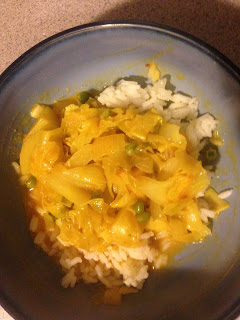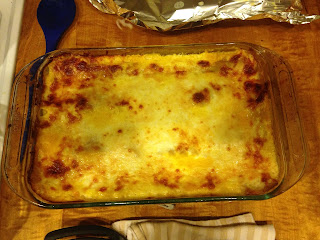Do you still have sweet potatoes? We have been LOVING them roasted (cubed and tossed with oil and salt then roasted at 400° F for about 30 minutes). This week I made a shortcut aioli to dip them in, which was delicious, but not necessary; they stand alone. But we still have a bit of a surplus right now from our own garden, including some small ones that were starting to go soft.
This morning I boiled them up and made sweet potato pancakes for Halloween morning brunch. We needed the nourishment as we put the finishing touches on our costumes; Jonathan had been crafting me a gavel out of chestnut from our yard and I had been helping him figure out where to glue the hair on his bald cap. What a great holiday.
I (with help from Josie and Jonathan) adapted this recipe for a program at work, using the seasoning blend that I use for pumpkin pie filling instead of just the nutmeg suggested in the original recipe.
This morning I subbed oat flour for the all-purpose flour. I love the added nutty flavor that oat flour gives to baked goods, but it is heavy, so if you are looking for very light and fluffy pancakes you may want to steer clear. Pancakes don't really rely on gluten to hold them together so as far as I know you are pretty safe to sub whatever flour you like. That being said, I did find these a bit more crumbly than the ones we made at work with AP flour. I made small pancakes (less than 1/4 cup batter for most) to account for this.
We topped the pancakes with homemade whipped cream and maple syrup. They were incredibly moist, bordering on gooey, in the best way possible. They tasted a lot like pumpkin pie and were more than a little addicting.
Sweet Potato Pancakes
Adapted from here and here
Serves 2-3
Ingredients
- 3/4 cup flour (whole grain oat flour is my favorite so far, see notes above)
- 1 tbsp. sugar
- 1 3/4 tsp. baking powder
- 1/2 tsp. salt
- 3/4 tsp. cinnamon
- 1/4 tsp. nutmeg
- 1/4 tsp. ginger
- 1/8 tsp. cloves
- 3/4 cup sweet potato, boiled whole until tender, peeled, and mashed
- 1 egg
- 3/4 cup milk
- 2 tbsp. melted butter (plus extra if you like to cook the pancakes in butter like me)
- Whipped cream and maple syrup for serving
Directions
- Combine the dry ingredients in a small bowl.
- Beat the egg in a medium bowl, then add the milk, butter, and sweet potato.
- Mix slightly, then add the dry ingredients and mix until moist.
- At this point I like to use an immersion blender to puree the batter and take care of any lingering chunks of sweet potato, but you can continue to mix by hand or with a hand mixer. Maybe use a potato masher if the sweet potato chunks are giving you trouble.
- Heat a skillet (I like cast iron) over medium-low to medium heat. Spray with cooking spray or melt some butter in the skillet (my preference), then add ~1/4 cup (see note above) of batter to make a pancake, flattening a little if needed and repeating until the skillet is full.
- Cook for a few minutes, then flip and cook for a few minutes on the other side (these tend to brown pretty quickly, but they taste good browned - I think it's the sugar).
- Transfer to a warm oven until ready to serve.
- Top with whipped cream and maple syrup. Try not to eat them all. Or do, they're kind of healthy!


















